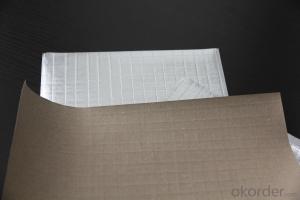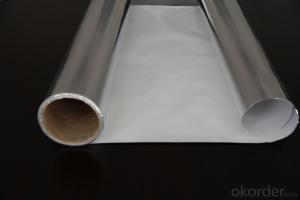Aluminum Foil Facing Reinforced Kraft Paper
- Loading Port:
- China Main Port
- Payment Terms:
- TT OR LC
- Min Order Qty:
- -
- Supply Capability:
- -
OKorder Service Pledge
Quality Product, Order Online Tracking, Timely Delivery
OKorder Financial Service
Credit Rating, Credit Services, Credit Purchasing
You Might Also Like
Material Structure: AL/3 way scrim/ADHESIVE
| ||
Paper Weight:60gsm ( Standard, can be Customized) | ||
Roll Size:1.2m*50m ,1.25*50m (can be customized) | ||
PROPERTIES | TEST DATA | UNIT |
Thickness | +-0.15 | mm |
Weight | +-110 | gsm |
Emissivity | 0.03-0.04 | COEF |
Thermal conductivity | 0.037 | w/m0 |
Bursting Strength | 90 | N/25mm |
Reflectivity | 96-97 | % |
Water Vapour Transmission | 1.15 | Ng/N.S |
Corrosion | doesn't generate | |
Tensile Strength(MD) | 144.4 | N/25mm |
Tensile Strength(TD) | 46.3 | N/25mm |
- Q: Is it safe to use aluminum foil as a facing material for making soups or stews?
- <p>Yes, you can use aluminum foil facing to make soup or stew. Aluminum foil is a common material used in cooking and is safe for contact with food at normal cooking temperatures. It is often used to cover pots to retain heat and moisture, or to create packets for cooking food directly on the heat source. However, it's important to ensure that the foil does not tear or come into direct contact with the heat source, as this could cause it to burn and potentially release aluminum into the food. Always follow safety guidelines and use foil responsibly in cooking.</p>
- Q: This question is asking for instructions on how to clean and store aluminum foil rolling film to maintain its quality and usability.
- <p>To clean aluminum foil rolling film, gently wipe it with a damp cloth to remove any residue. Avoid using abrasive materials that could scratch the surface. After cleaning, let it dry completely. To store, roll the film tightly and wrap it in a protective layer, such as a plastic wrap or a clean cloth, to prevent dust and scratches. Store it in a cool, dry place away from direct sunlight to maintain its integrity.</p>
- Q: What distinguishes aluminum foil facing from other types of facing materials?
- <p>Aluminum foil facing is a type of facing material that uses a thin layer of aluminum, known for its excellent barrier properties against air, moisture, and light. This makes it ideal for insulation and packaging applications where preservation of contents is crucial. In contrast, other types of facings, such as paper, fabric, or plastic, may not offer the same level of barrier protection. Paper facings are often used for their aesthetic appeal and are more breathable, while fabric facings provide flexibility and are used for applications requiring durability and comfort. Plastic facings can be waterproof and are used where a shiny or smooth surface is desired. Each type of facing has unique properties that make it suitable for specific applications, with aluminum foil facing being particularly notable for its barrier capabilities.</p>
- Q: What are the safety regulations or guidelines that aluminum foil facing must adhere to?
- <p>Safety standards for aluminum foil facing are crucial to ensure the product's safety and effectiveness. These standards typically include requirements for material composition, thickness, and bonding strength to ensure the foil's durability and resistance to tearing. Additionally, there are guidelines for the foil's reflectivity and heat resistance, which are important for its performance in various applications. Compliance with these standards is often verified through testing and certification processes, ensuring that aluminum foil facing products meet the necessary quality and safety benchmarks before they reach the market.</p>
- Q: Is it possible to use aluminum foil with a shiny side facing up to line a baking sheet for the purpose of facilitating easier cleanup?
- <p>Yes, you can use aluminum foil facing to line a baking sheet for easier cleanup. The shiny side of the aluminum foil is often smoother, which can help prevent food from sticking and make it easier to slide food off the sheet. Additionally, it can catch spills and drips, reducing the mess on the baking sheet itself. However, it's important to ensure that the foil is properly secured to prevent it from sliding around or causing uneven heating.</p>
- Q: This question asks for methods to utilize aluminum foil as a tool for preparing quick and easy meals.
- <p>Aluminum foil facing is a versatile tool for quick meal preparation. One method is the 'foil packet' technique, where you place ingredients like vegetables, protein, and seasonings in a foil pouch and bake or grill. This method helps retain moisture and flavor. Another way is to use foil as a makeshift baking tray for items like fish or potatoes, which can be seasoned and wrapped in foil for a one-step cleanup. Foil can also be used to cover food during grilling to prevent flare-ups or to steam vegetables. Always ensure food is cooked thoroughly and be cautious of potential aluminum leaching, especially with acidic foods.</p>
- Q: Is it safe to use aluminum foil with a nonstick coating for cooking or baking purposes?
- <p>Using nonstick-coated aluminum foil for cooking or baking is generally safe, but it's important to follow the manufacturer's guidelines regarding temperature limits. Nonstick coatings are designed to withstand high temperatures, but excessive heat can cause them to break down or release harmful fumes. Always ensure the foil is placed in a way that the nonstick side does not come into direct contact with the heat source to prevent damage to the coating. Additionally, avoid using sharp or abrasive objects on the nonstick surface to maintain its integrity.</p>
- Q: What are the potential health hazards linked to the use of aluminum foil facing?
- <p>The use of aluminum foil facing in construction or insulation can potentially pose health risks. Inhalation of aluminum dust can lead to respiratory issues, and long-term exposure may contribute to neurological problems. There's also a concern about the leaching of aluminum into food when using aluminum foil for cooking or food wrapping, which some studies suggest could be linked to Alzheimer's disease, although this link is not definitively proven. It's important to handle aluminum foil facing with care, ensuring proper ventilation and protective gear during installation to minimize health risks.</p>
- Q: This question asks if there are any potential issues or risks associated with storing food in plastic containers for extended periods.
- <p>Yes, there are concerns about using plastic containers for long-term food storage. Certain plastics can leach chemicals, such as BPA (Bisphenol A) and phthalates, which may be harmful when ingested over time. These chemicals can migrate into the food, especially with exposure to heat or over extended periods. Additionally, plastic containers can break down over time, potentially releasing harmful substances into the food. It's recommended to use food-grade, BPA-free plastics or alternatives like glass containers for long-term storage to minimize health risks.</p>
- Q: This question asks for methods to clean the aluminum foil facing, which is a common household material used for cooking and food storage.
- <p>To clean aluminum foil facing, start by removing any visible debris. Use a damp cloth or sponge with mild dish soap to wipe the surface gently. Avoid abrasive materials that could scratch the foil. If there are stubborn stains, you can use a mixture of water and vinegar (1:1 ratio) to dampen the cloth. Wipe the surface and let it air dry. For baked-on food, you can use a plastic scraper or a soft nylon brush to gently remove it. Always remember to handle aluminum foil carefully to prevent tearing or damaging the surface.</p>
Send your message to us
Aluminum Foil Facing Reinforced Kraft Paper
- Loading Port:
- China Main Port
- Payment Terms:
- TT OR LC
- Min Order Qty:
- -
- Supply Capability:
- -
OKorder Service Pledge
Quality Product, Order Online Tracking, Timely Delivery
OKorder Financial Service
Credit Rating, Credit Services, Credit Purchasing
Similar products
Hot products
Hot Searches
Related keywords































